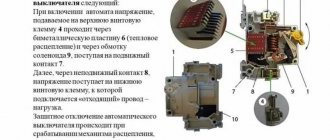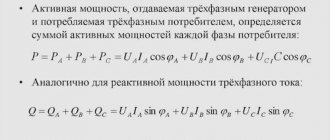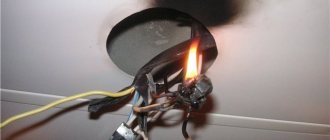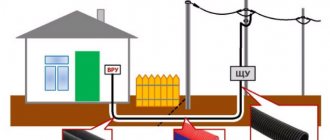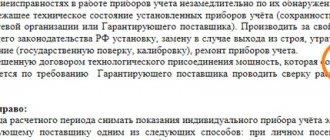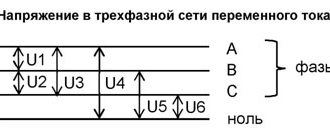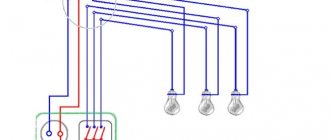Before purchasing a wire, be sure to measure its cross-section. Moreover, if you change the wiring or add a new point to the old one, then in this situation you will need to measure the cross-section of the wire. Since all wires are of different diameters, their cross-section is different. Nowadays, there is often deception on the part of the manufacturer. For example, the specified wire diameter for sale is not entirely reliable. Therefore, rather than be deceived, it is better to determine the size of the conductor yourself. We will teach you how to determine the cross-section of a wire by diameter.
Wire diameter
Wire diameter and what materials the wires can be made of
A conductor transmits a certain amount of energy. This amount depends on many factors, the main one of which is the material from which the conductive conductors are made. The following non-ferrous metals can be used as the core material of wires and cables:
Aluminum. Their main advantage is that aluminum conductors are cheap and lightweight. Among the negative qualities, the following can be noted: tendency to mechanical damage, low electrical conductivity, high transient electrical resistance of oxidized surfaces.
Copper . This metal is the most popular in comparison with other competitive options. They are distinguished by the following main properties: low electrical and transition resistance at the contacts, fairly high elasticity and strength, as well as ease of soldering and welding.
Aluminum copper. A peculiar synthesis of two metals. These are cable products with aluminum cores coated with copper. They are characterized by slightly lower electrical conductivity than their copper counterparts. They are also lightweight and have average resistance while being relatively cheap.
Materials from which wires are made
Calculation of wire cross-section
Strictly speaking, the concept of “thickness” for a wire is used colloquially, and the more scientific terms are diameter and cross-sectional area. In practice, the thickness of the wire is always characterized by its cross-sectional area.
In practice, calculating the wire cross-section is very simple. Knowing the diameter (for example, by measuring it with a caliper), you can easily calculate the cross-sectional area using the formula
S = π (D/2)2 , where
- S – wire cross-sectional area, mm2
- π – 3,14
- D – diameter of the conductor of the wire, mm. It can be measured, for example, with a caliper.
The formula for the cross-sectional area of a wire can be written in a more convenient form: S = 0.8 D² .
Amendment. Frankly, 0.8 is a rounded factor. A more accurate formula: π (1/2)2 = π / 4 = 0.785.
Thanks to attentive readers
Let's consider only copper wire , since it is used in 90% of electrical wiring and electrical installations. The advantages of copper wires over aluminum wires are ease of installation, durability, and reduced thickness (at the same current).
But with an increase in diameter (sectional area), the high price of copper wire eats up all its advantages, so aluminum is mainly used where the current exceeds 50 Amperes. In this case, a cable with an aluminum core of 10 mm2 or thicker is used.
The cross-sectional area of the wires is measured in square millimeters. The most common cross-sectional areas in practice (in household electrics): 0.75 (prohibited in fixed wiring), 1.5, 2.5, 4 mm2
There is another unit for measuring the cross-sectional area (thickness) of a wire, used mainly in the USA - the AWG system . On Samelektrika there is a table of wire cross-sections according to the AWG system and conversion from AWG to mm2.
Regarding the selection of wires, I usually use catalogs from online stores, here is an example of copper. They have the largest selection I've ever seen. It’s also good that everything is described in detail - composition, applications, etc.
I also recommend reading my article about choosing a wire cross-section for direct current; there are a lot of theoretical calculations and discussions about voltage drop, wire resistance for different cross-sections, and which cross-section to choose is optimal for different permissible voltage drops.
And another article - Voltage drop on long three-phase cable lines. a real example of an object is given, formulas and recommendations are given on how to reduce losses. Wire losses are directly proportional to current and length. And inversely proportional to resistance.
When choosing the cross-sectional area of the wires, you should be guided by three basic principles.
- The cross-sectional area of the wire (in other words, its thickness) must be sufficient for the passage of electric current through it. Sufficient - this means that when the maximum possible current in this case passes, the heating of the wire will be acceptable (as a rule, no more than 60 0C)
- The cross-section of the wire must be sufficient so that the voltage drop across it does not exceed the permissible value. This is especially true for long cable lines (tens and hundreds of meters) and high currents.
- The thickness of the wire and its protective insulation must ensure its mechanical strength, and therefore reliability.
For example, to power a chandelier in the living room, light bulbs with a total power consumption of 100 W (current slightly more than 0.5 A) are used. It seems that wires with a cross-sectional area of 0.5 mm2 are quite enough? But what electrician in his right mind would install such a wire in a ceiling slab? In this case, 1.5 mm2 is usually used.
In fact, the choice of wire thickness depends on one parameter - the maximum operating temperature.
If this temperature is exceeded, the wire and the insulation on it will begin to melt and collapse. In other words, the maximum operating current for a wire with a certain cross-section is limited only by its maximum operating temperature. And the time that the wire can work in such conditions. Below is a well-known table of wire cross-sections for selecting the cross-sectional area of copper wires depending on the current. The initial data is the cross-sectional area of the conductor.
Wire diameter and methods for determining wire cross-section by diameter
The diameter of any conductor must match the parameters specified in the documentation that comes with it. However, such a complete coincidence, unfortunately, does not always occur. For example, if the marking says that the cable is 3 X 2.5 , then its cross-section should be at least 2.5 mm2 . But when you check it yourself at home, the result may well not be what the manufacturers promised. It will not be surprising if it turns out that the wire is 20-30% less than the stated figure. Therefore, it is better to check and determine the wire cross-section by diameter additionally.
To determine the diameter of the wire, you need to measure it. In this case, the measuring instruments can be a caliper or a micrometer . They use mechanical and electronic (with digital screen). The first option is more common and is measured more often, but in some cases electronic devices are preferred.
Basically, they measure wires and cables using a caliper, since this device can be found in almost every household. It can also measure the diameter of wires in a working network, for example, a socket or panel device.
In fact, there are several ways to determine the diameter of a wire. Each is based on determining the diameter a of the core with subsequent calculations of the final results.
Method one. Using instruments that help measure the diameter of a wire or wire strand. And also using the formula.
Wire Diameter - Measurement
This option is primarily suitable for professional electricians who are constantly installing electrical wiring. That is, the person conducting the measurements must have experience in this area. Of the two measuring instruments, the most accurate results can be obtained using a caliper. The advantage of this device is that it allows you to measure the diameter of a wire even on a section of a working line, for example, in a socket.
Appearance of a mechanical micrometer
We talk here about what types of switches there are.
Determining the wire cross-section using the formula
After you have measured the diameter of the wire , you need to make calculations using the following formula:
Determining the wire cross-section using the formula
The above formula is suitable for all measurements.
It must be remembered that the number "Pi" is 3.14, so if we divide the number "Pi" by 4, then we can simplify the formula and reduce the calculation to multiplying 0.785 by the diameter squared.
Also, to determine the cross-section, the formula for finding the area of a circle by diameter is also suitable. It looks different: S = π/4 X D2 . This formula is more labor-intensive, but, in any case, by substituting the numbers and solving the example, we get the same result. In cross-section, any cable core has the shape of a circle. It doesn't matter whether it's wire or wire. What is the wire cross-section? This is nothing more than the cut circumference area of the wire. And the area of any circle, knowing its diameter and radius, can be easily calculated using a simple formula familiar to everyone from school: S = πR2 . “π” is a constant number and is always equal to 3.14, “R2” is the radius squared.
We substitute the values into the formula, first dividing the diameter by two to find out the radius, because in this formula the area is found out precisely with its help. It turns out: S = 3.14 X 0.342 . All you have to do is solve this simple example, the result is 0.36. What does it mean - the cross-section of the wire being tested is 0.36 mm2. But it is better not to use such a “weak” wire in the power network.
Method two.
Measuring wire cross-section using a ruler. If you do not have one of the special measuring devices and you decide not to spend money on purchasing one, then you can use an available proven method for measuring. Take a simple pencil, ruler and wire. Strip the core of insulation. To do this, wind it tightly onto a pencil, and then use a ruler to measure the total length of the winding.
Measuring wire cross-section using a ruler
Then divide the length of the wound wire by the number of cores. The resulting value will be the diameter of the wire cross-section.
So you need
1. Clean the insulating layer of the core;
2. Wind the turns around the pencil tightly to each other (there should be at least 15-17 pieces);
3. Measure the winding length;
4. Divide the resulting value by the number of turns.
Rules to consider when performing this work:
- the more cores you wind on a pencil, the more accurate the result will be; the number of turns should be at least 15;
- try to press the turns tightly against each other so that there is no free space between them, this will significantly reduce the error;
- The measurements must be repeated several times (while changing the side of the measurement and the direction of the ruler). By getting multiple results, you have a better chance of avoiding large errors.
Disadvantages that you should pay attention to with this measurement method:
- You can only measure the cross-section of thin wires, since it will be difficult for you to wind a thick wire around a pencil.
- You will need to purchase a small piece of the product first before making the main purchase.
Method three. Measuring the cross-section by wire diameter using a table. Using this particular method, you do not have to carry out calculations using the formula. In a specially selected table for your convenience, the diameter of the wire (in millimeters) and the cross-section of the conductor (in square millimeters) are already indicated.
Read here about what to do if a person is electrocuted. Everyone should know this!
Power of household electrical appliances
Let us take, for example, household electrical appliances that are familiar to every person, in order to show by their example how the consumer power of one electrical installation consisting of several circuits is determined. When you buy a device that operates on electric current, it must be accompanied by documents from the manufacturer, where the power of the unit is indicated in watts or kilowatts. But these are not the indicators that determine the output, as on the speakers, these figures indicate the electricity consumption in the network in the ratio of kWh. For example, if you have a 6 kW single-phase electric boiler installed, this means that for an hour of operation of the unit you will need to pay for the consumption of 6 kW of electricity (accounting occurs only when the boiler is active).
But, in addition to powerful energy consumers, there are also devices of medium and low power. This is an iron, a regular microwave or microwave oven, a refrigerator, a vacuum cleaner, a computer, a TV and, of course, light bulbs, which a modern room cannot do without. All these devices, which can be turned on and simultaneously consume voltage, which is recorded by the electric meter, determine the rated power of one electrical installation. But for a correct calculation, you need to sum up the number of watts consumed by each device and multiply by a factor of 0.8 - this way you can get a real indicator by which to evaluate the total load.
For example, in order to calculate the actual power consumption in the kitchen, you need to determine how many circuits there are, since they may be separate: one for lighting, the other for sockets. Therefore, the total power (Ptot) will be equal to the sum of the consumption of all devices that can be connected in this room and multiply all this by 0.8.
To do this, use a simple formula: Ptot = (Refrigerator + Microwave + Mixer +...+ Electric kettle) * 0.8.
In this case, it does not matter whether the accounted energy consumers will ever be connected at the same time or not - to equalize, there is a multiplication of the amount by a factor of 0.8. This is a very important point for determining the required cross-section of electrical wiring that will be made for a particular electrical installation and its circuits.
Wire diameter and diameter correspondence table with definition of cross-section
This table will save you from the need to make unnecessary calculations. Despite the fact that each cable coil has a tag that indicates its marking and all its parameters, you should not trust what is written. It would be better to play it safe and measure the diameter of the conductor, and then use the table to estimate approximately what its cross-section is.
| Diameter of conductor element, mm | Cross-sectional area of the conductor element, mm2 |
| 0,8 | 0,5 |
| 0,9 | 0,63 |
| 1 | 0,75 |
| 1,1 | 0,95 |
| 1,2 | 1,13 |
| 1,3 | 1,33 |
| 1,4 | 1,53 |
| 1,5 | 1,77 |
| 1,6 | 2 |
| 1,8 | 2,54 |
Diameter correspondence table with definition of cross-section
Cable products with a cross-section of up to 10 mm2 are almost always produced in a round shape. To meet the domestic needs of houses and apartments, such conductors are quite sufficient. However, with a larger cross-section of the cable, the input cores from the external electrical network can be made in segment (sector) form, and it will be quite difficult to determine the cross-section of the wire by diameter.
It is best to use a micrometer or caliper to measure the thickness (diameter) of the wire. Micrometers are a priority, it doesn’t matter - mechanical or electronic, they will show the most accurate result. However, the results given by a caliper will also work quite well. To make a measurement, you need to clean the wire from the plastic insulation, but not every seller will allow such actions with the end of the wire on a coil put up for sale. Therefore, it is best to buy a meter of cable in advance and then take measurements. Once data on the diameter of the core has been obtained, you can begin to calculate the cross-section.
Marking of wires by diameter
In particular, the following will be written on the tag: “VVNG 2x4.” This encoding means the following: in the cable - the number of cores is 2, each of which has a cross-section of 4 mm2. To confirm or refute the stated parameters, we measure the diameter of the cable core without insulation using one of the methods. We carry out calculations.
Wire marking
What load can copper wires with a cross-section of 1, 1/5, 2, 2/5 square withstand, what can be connected?
Of the cross-sections of current-carrying conductors of a copper wire indicated in the question, a wire with a cross-section of 1 square millimeter is perhaps the most rarely used. This wire can be used to make internal switching of a chandelier or lamp; for each light bulb in the chandelier it will be more than enough, because individually they rarely exceed 500 Watts. With a wire of 1 square millimeter, today you can also install a lighting line for internal electrical wiring in which energy-saving or LED lamps will be used; their power is low and a wire of one square is enough. Why in a private house? Yes, because the wiring of apartments is still done according to the PUE and must have a cross-section of at least 1.5 square meters. The total power that a wire with a cross-section of 1 square millimeter can withstand is 2200 Watts (2.2 Kilowatts) (10 Amperes). You can connect any device whose power does not exceed this value. For example, it is not critical to connect a hair dryer, computer, TV, video set-top box, power supply for video surveillance systems, mixer... When determining the power characteristics of a device, you must first of all refer to its passport data indicated in the passport plate (usually pasted on the device in an inconspicuous place)
Further, in the explanation of the question, the most “running” sections of copper wire cores are indicated - 1.5 mm and 2.5 mm.
Wire with a cross-section of 1.5 is usually used in lighting, although the power reserve in the lighting line is not very bad. By the way, the maximum permissible load on the wire should not be taken as standard; there should always be a reserve of power, about 10 percent. In this case, your wire will never heat up even if all consumers are turned on for a long time, especially the connection points, which are the weakest link in any electrical circuit.
Below is a table of the ratios of the cross-sectional area of the core, permissible current and power. So these are the peak values, subtract 10 percent from them and your wiring will not overheat with any installation method - closed or open wiring.
As you noticed, the value of current and power for different voltages is also different. The question does not indicate the voltage, so I give it for both a 220 Volt network and a 380 Volt network.
So what can we connect in a 220 Volt household network to a wire in -
- 1.5 square - 3500 Watt. This can be at the same time an electric kettle of 2 Kilowatts + a Hairdryer of 250 Watts + a mixer of 250 Watts + an iron of 1 Kilowatt.
— 2.5 square — 5500 Watt. This can be at the same time, all the same, a 2 Kilowatt electric kettle + a 250 Watt hair dryer + a 250 Watt mixer + a 1 Kilowatt iron + a 500 Watt TV + a 1400 Watt vacuum cleaner.
This is just a calculation of power with a margin based on the capabilities of the wire.
You may ask why I didn’t give the number of consumers and their power for a wire with a cross-section of 2 squares? Yes, because the main cross-section of copper wires is 0.75; 1; 1.5; 2.5; 4; 6; 10 squares. I do not exclude that for a narrow purpose a copper wire with a cross-section of 2 square meters. mm. and there is, but not in retail sale.
The question emphasizes “..in my own words..” but nevertheless, for educational purposes, I will give a table of the ratios of the power of electrical appliances to the current consumed, so it will be easier to correlate the existing device, its power (or the total power of several devices) and the current consumed by them and the corresponding cross-section of the copper core.
Seeing this sign and knowing that 1 square millimeter of wire can withstand a current of 10 Amps, we can easily calculate the maximum possible power for our wire.
For example, an electric kettle with a power of 1500 Watt consumes a current of 6.8 Amperes. It turns out that for a wire with a cross-section of 1 square, powering such a kettle will not be critical, even with a good power reserve. But for a kettle with a power of 2000 Watts, a wire of the same cross-section will already lie in the “red zone” of the permissible load, and its constant use for this purpose is unacceptable; you need to take a larger cross-section.
Conductor markings (wire diameter)
If the cross-section coincides with that indicated on the tag, great, you can safely take it. But when the resulting result is much less, you should opt for a more powerful cable that has the next best parameters. Otherwise, you can look for wires in other stores. Unfortunately, high-quality goods that meet GOST standards are not so easy to come by these days. Remember that a high-quality cable will not be cheap. The conclusion follows from this: if you want to get a quality product, look for trusted stores with markings that comply with GOST.
Before making a final decision - to take or not to take the wire, it is necessary to inspect the insulation very carefully. The plastic shell of the core must be continuous, have an impressive thickness, which will be the same along the entire length. If, in addition to discrepancies in diameter, negative nuances with the braid are also revealed, then of course you need to look for another store where the cable would be purchased elsewhere and from a completely different manufacturer. It's better not to take risks with electricity.
Therefore, it is better to overpay, perhaps spend more time searching, but buy a high-quality conductor made according to GOST, and not made according to specifications. In this case, you can guarantee that the cable will serve the time stated in the documents without any problems, and, most likely, much longer. The choice of wires is a very serious matter, and it certainly cannot be handled carelessly. You should not risk the building just to reduce the search time or save extra pennies.
Determining the cross-section of a stranded wire
Stranded wires contain many thin wires inside them. How to determine the wire cross-section in this case? Some “craftsmen” twist all the wires into one tight twist, measure it with a caliper and calculate the cross-section using the found diameter.
Diameter of stranded wires
But this is completely the wrong approach. Only a micrometer is suitable for this option. To measure the cross-section of a stranded conductor, you need to measure the diameter of one small wire. Having received the result of the cross-section of one wire, you should count the number of others, then multiply the cross-section of one wire by the total number of wires. Only in this sequence of actions will the cross-section of the stranded wire have the correct parameters.
Aluminum cable with sector conductors
Cable type : Segment cross-sectional area, mm2 : S35 50 70 95 120 150 185 240
Four-core segment cable type - cross-sectional area h - 7 8.2 9.6 10.8 12 13.2, as well as w - 10 12 14.1 16 18 18
Three-core segment stranded 6(10) - h 6 7 9 10 11 12 13.2 15.2, as well as w 10 12 14 16 18 20 22 25
Three-core segment single-wire , 6(10) - h 5.5 6.4 7.6 9 10.1 11.3 12.5 14.4, as well as w 9.2 10.5 12.5 15 16.6 18.4 20.7 23.8
These are indications where the name of the cable type is on the left, and on the right opposite it is the cross-sectional area of the segment. Where the size (height, width) of the cable takes on the corresponding cross-sectional area. Initially, it is necessary to measure the height and width of the required segment with a ruler, after which the required parameter can be calculated by correlating the obtained data.
Aluminum cable with sector conductors
When choosing a cable, you must be guided by several criteria:
- the strength of the electric current that the cable will pass;
- power consumed by energy sources;
- current load exerted on the cable.
Power (wire diameter)
The most important parameter during electrical installation work (in particular, cable laying) is throughput. The maximum power of electricity transmitted through a conductor depends on the cross-section of that conductor itself. Therefore, it is extremely important to know the total power of the energy consumption sources that will be connected to the wire. Often, household appliances and other electrical appliances indicate the maximum and average power consumption on the label and in the accompanying documentation.
If, for example, a washing machine in the process of washing clothes can consume electricity in the range from tens of W/h during rinsing mode to 2.7 kW/h when heating water. This is a lot of power and naturally, a wire with a cross-section that is sufficient to transmit electricity of maximum power must be connected to it. In the case when two or more consumers are connected to the cable, the total power is determined by adding the limit values of each of them. The average power of all electrical appliances and lighting devices in an apartment rarely exceeds 7500 W for a single-phase network. Accordingly, the cable cross-sections in the electrical wiring must be selected to this value.
For example, for a total power value of 7.5 kW, it is necessary to use a copper cable with a core cross-section of 4 mm2, which is capable of transmitting about 8.3 kW. The cross-section of the conductor with an aluminum core in this case must be at least 6 mm2, passing a current power of 7.9 kW.
In some special residential buildings, a three-phase power supply system of 380 V is often used. But the fact is that most equipment is not designed for such electrical voltage. A voltage of 220 V is created by connecting them to the network through a neutral cable with an even distribution of the current load across all phases.
What power can a cable with a cross section of 1.5-2.5-4 mm² withstand?
To more accurately determine what load to allocate to a cable of a certain cross-section, we will use this rule - 1 mm² of copper wire can withstand a current of 10 Amps. What does it mean? In fact, everything is simple and all we have to do is convert amperes to kW.
10 Amps is approximately 2 kW of power (average value). Therefore, a cable with a cross-section of 1.5 mm² can withstand about 3.5 kW. Let's see how much power conductors of a different cross-section can withstand, and also consider the calculation table, which will be presented below.
At the same time, you need to understand that in a three-phase 380 V network, the current and power parameters are always different. Much also depends on the materials used to make the conductor. Copper and aluminum wires with the same cross-section can withstand different loads - copper is much larger than aluminum.
Copper wire load calculation table
- Wire 1.5 mm² - can withstand 3.3 kW;
- Wire 2.5 mm² - can withstand 4.5 kW;
- Wire 4 mm² - will withstand about 6 kW.
All these values are relevant for a single-phase 220 Volt network and wires for which copper was used.
In three-phase networks, if you look at the cable power calculation table, the figures are much higher.
Electric current (wire diameter)
Quite often you can encounter a situation where the power of electrical equipment and equipment is not known to the owner due to the absence of this characteristic in the documentation or the loss of the necessary documents and labels. There is always a way out. For this situation, it is as follows: make the calculation using the formula yourself. Power is determined by the formula:
P = U*I,
Where:
- P – power, measured in watts (W);
- I – electric current strength, measured in amperes (A);
- U is the applied electrical voltage, measured in volts (V).
When the strength of the electric current is unknown, it can be measured with control and measuring instruments: an ammeter, a multimeter, and a clamp meter.
After determining the power consumption and electric current, you can use the table below to find out the required cable cross-section.
Measuring with pliers
| Wire cross-section. | Electrical voltage 220 V | Electrical voltage 380 V |
| Current strength A; Power, kWt | Current strength A; Power, kWt | |
| 2,5 | 27 5,9 | 25 16,5 |
| 4 | 38 8,3 | 30 19,8 |
| 6 | 50 11 | 40 26,4 |
| 10 | 70 15,4 | 50 33 |
| 16 | 90 19,8 | 75 49,5 |
| 25 | 115 25,3 | 90 59,4 |
| 35 | 140 30,8 | 115 75,9 |
| 50 | 175 38,5 | 145 95,7 |
| 70 | 215 47,3 | 180 118,8 |
| 95 | 260 57,2 | 220 145,2 |
| 120 | 300 66 | 260 171,6 |
What should you consider when selecting the cable cross-section?
When selecting cable cross-sections, it is important to consider two main parameters. First of all, this is the load that will fall on the conductors. That is, you need to know how many and what electrical appliances will “sit” on the selected cable. Then, based on these parameters, a circuit breaker is selected, the rating of which should be as close as possible to the current strength that the conductor is capable of passing through itself.
For ordinary sockets in the house, a copper wire with a cross-section of 2.5 mm² is sufficient. It will be possible to connect an iron, ironing board and even a heater with a power of 2-3 kW to such sockets. In this case, the total power of all electrical consumers connected to the outlet should not exceed 3.5 kW (about 16 Amperes).
For lamps and lighting groups, it is enough to stretch a cable with a cross-section of 1.5 mm². In the kitchen, if there is an electric stove, the wire should be selected with a power reserve. Most often it is 4 or 6 mm², depending on the power of the electric stove.
Thus, knowing what load the wire will withstand, you can easily select it correctly. In this case, it is important to take into account the materials used to make the conductor and the methods of its installation, since a lot depends on these nuances.
Load (wire diameter)
Calculation of the cross-section of cable products based on current load must be carried out to further protect them from overheating. If too much electric current passes through the conductors for their cross-section, destruction and melting of the insulating layer may occur. The maximum permissible long-term current load is the quantitative value of the electric current that can pass the cable for a long time without overheating. It's important to know this. To determine this indicator, it is initially necessary to sum up the powers of all energy consumers. After this, calculate the load using the formulas:
I = P∑*Ki/U (single-phase network),
I = P∑*Kи/(√3*U) (three-phase network),
Where:
- P∑ – total power of energy consumers;
- Ki – coefficient equal to 0.75;
- U – electrical voltage in the network.


